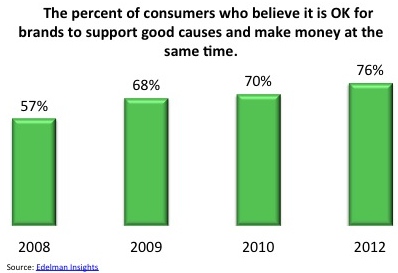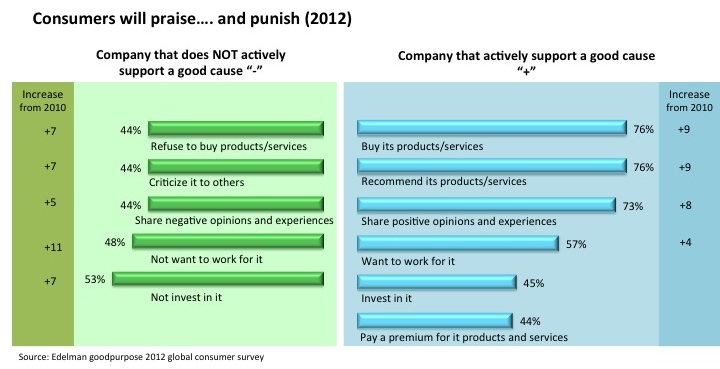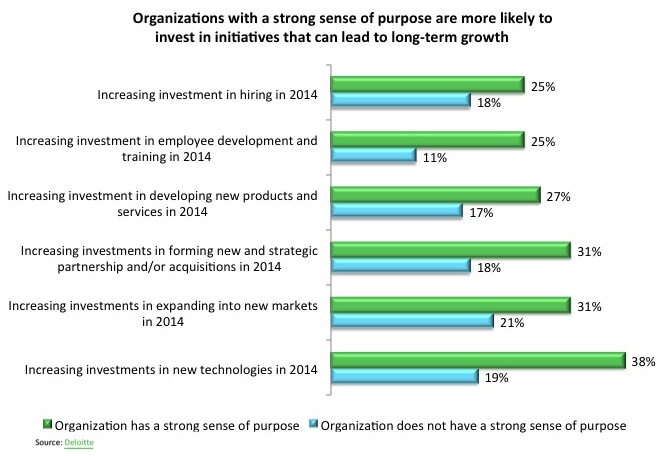June 2014: Though it feels like the information economy has only just begun, there’s another type of economy emerging. This new economy – the purpose-driven economy – is changing what we do in and with our professional lives. It is being also increasingly highlighted in events such as the Inclusive Capitalism Conference in London.
The purpose-driven economy has its roots in both corporate purpose statements and the non-profit sector. But it is not about fighting for a certain cause but more about finding a way of living and working where the purpose of what you are doing is an important driver shaping your decisions, actions and ways of working. It is evident that an increasing number of people and organizations are following this path, developing new business models that reflect the shift in mindset from pure profit to profit and purpose, or even the 3Ps (people, profit, planet). Examples include the rise of B Corporations, hybrid non-profit and for-profit organizations, philanthrocapitalism, social entrepreneurship, and crowd-driven philanthropy. Collaboration and innovation are at the heart of many of these business models, allowing ordinary people to do “big things” while also making money.
Driven by trends including increasing globalization, new technologies, geopolitical events, cross-industry competition, and new generational mindsets, expect more individuals, businesses and organizations to jump on the bandwagon and join the purpose-driven economy.
In the newly released book The purpose economy: How desire for impact, personal growth and community is changing the world Aron Hurst, who is a globally recognized entrepreneur, founder of Taproot Foundation and CEO of Imperative, describes the purpose economy as an economy that “…is defined by the quest for people to have more purpose in their lives. It is an economy where value lies in establishing purpose for employees and customers – through serving needs greater than their own, enabling personal growth, and building community.”
In this briefing we take a look at how this new mindset is changing our future economies. How are businesses and organizations using purpose to create value? Which markets do they impact? What is driving this emerging economy? Are these changes for real?
NEW: Also see our slideshow presentation of The purpose-driven economy here
Profit and purpose – new business models for new types of value creation
People want to make money but they also want to make a difference with individuals and businesses becoming more actively engaged in addressing global as well as local challenges. In many organizations, purpose is playing a growing role in shaping agendas, reflected in a growing emphasis on objectives such as shared value and responsible capitalism. In addition there is a new generation of hybrid organizations emerging which combine purpose and profit, from non-profits undertaking some business activities to generate the more predictable cash flows to fund longer-term projects, to business organizations pursuing societal as well as economic value. And public opinion is on board:

Social entrepreneurship for a reason
Social entrepreneurs are popping up everywhere, demonstrating through innovative approaches that profitmaking and social good can go hand-in-hand. Examples include:
ThinkImpact – social change through relationships and ideas: ThinkImpact is an educational travel company that does not have volunteer, intern or study abroad programs and does not perform traditional international development work. Rather it seeks to bring together students and local community members to spark ideas and create businesses in rural Africa and Latin America by sending students around the world to explore different cultures, tackle tough challenges, and form relationships with people they would not otherwise meet. It started as a non-profit but is now reincarnated as a for-profit. (Source: New York Times)
Pencils of promise – a pen is enough to change a life: Since Pencils of Promise was founded in 2008, it has helped break ground on over 200 schools, but it does not just build the schools. The organization involves the local community, which needs to put in around 10-20% of the funding for the project. Most of the time the community contributes through providing labor and materials, which founder Adam Braun says holds the community accountable for the project, as it is a value exchange between two parties in a business transaction. Instead of referring to the organization as a non-profit organization Adam Braun likes to say Pencils of Promise is a for-purpose organization, focused on the bottom line. However instead of gross profit, its bottom line is gross efficacy. (Source: Forbes)
Crowdfunding for the developing world
Government funding and private donations have slowed down as a consequence of the financial crisis and non-profits as well as individuals and businesses have had find new ways to finance their projects. Crowdfunding is an increasing source of funds, for example:
Watsi – Crowdfunded medical treatment for the developing world: Watsi is utilizing crowdfunding to provide medical care in the developing world. It enables donations as small as US$5 to directly fund medical care and resources and, unlike many other non-profits, donates 100% of their proceeds. Modeled after for-profit companies, the organization was able to raise US$1.2 million while spending only US$135,000, meaning that every dollar spent produced US$9 for low cost, high impact medical treatment in another country. The company’s day-to-day running costs are funded separately through private donors, foundations, and corporations. To date, the organization has funded medical treatments for more than 1,110 patients in 16 countries. (Sources: Watsi, Huffington Post)
My Ideal City – crowdfunding Bogotá, Columbia: Just like many other cities around the world Bogotá in Columbia has experienced rapid population growth in recent years. This has triggered infrastructure issues such as problems with transportation, security and housing, while widespread corruption and lack of political consensus has delayed progress in the city. To redevelop Bogotá a team of partners has launched the global conversation site My Ideal City. The site is open for everyone and discusses trends in urban living across the world. Its ultimate goal is to prepare Bogotá for the future by presenting an urban redevelopment plan to city planners. Bogotá is also home to the world’s first ever crowdfunded skyscraper. The world’s largest crowdfunding initiative has generated over US$200 million from more than 3,500 supporters to build the highest skyscraper in Colombia, not to mention the first new one in 40 years. (Source: PSFK, Phaidon)
Brands driving sustainable living
Sustainability is a big issue, given global challenges from obesity to climate change. To make impact on such issues some brands have chosen to cultivate early adopters, turning them into “tastemakers” so the broader mass of consumers starts to take notice of products and services that can drive positive change. These brands include:
Whole Foods Market – a healthier choice: With more than 37,000 supermarkets in the U.S., the 375 stores of Whole Foods Market, an American foods supermarket chain specializing in natural and organic foods, are just a drop in the ocean. However, this drop drives much greater impact than its size would suggest. The chain has created enough demand to support hundreds of suppliers and inspire new ones. It has also pushed established supermarket chains to introduce organic products to support this new wave of consumer “craving.” In 2012, around 81% of American families were buying organic product at least “sometimes” and American domestic organic food production increased circa 240% between 2002 and 2011, compared to with 3% for non-organic foods. Solid growth for organic products is expected to continue until 2018 in the U.S. (Source: The purpose economy: How desire for impact, personal growth and community, Food navigator-USA)
Tesla – a drive for the environment: WhileWhole Foods is driven, in particular, by a purpose to make an impact on people’s health, Tesla’s founder Elon Musk is driven by making an impact on the environment. His vision was different from the start. He wanted not only to build a market for electric cars but also to create an environment in which it could be successful, beginning with luxury cars, and then expanding over time to reach a broader consumer base. (Source: Fast Company)
Why a purpose-driven organization matters
Tapping into a rising consciousness among customers, employees and other stakeholders, many organizations and businesses are stepping up to a new role to enable positive innovation and change to tackle societal and economic challenges and at the same time promote business growth. In many areas, they are seeking to build legitimacy – and the license to operate – in the eyes of demanding and discerning consumers, who care about the impact and motivations of companies from whom they buy. In many cases, this is also to the benefit of the organizations that are seeking to develop long-term visions and ambitions in which purpose is a priority.
From a consumer point of view
For consumers, purpose has become personal and the new generations empowered by technology, high connectivity and social media have more power than ever to influence and make a difference to the world’s economic and societal challenges. They are not afraid to use this power…

From a business point of view
Despite uncertainty in the current economic climate and a slowed economic recovery Deloitte has found that there is a tight correlation between purpose and building business confidence, both short term as well as long term. Deloitte’s Core Beliefs and Culture survey revealed that 82% percent of respondents, who work for an organization with a strong sense of purpose, say that they are confident that their organization will grow this year, compared to 48 % of those who said their organization did not have a strong sense of purpose.

While being an organization with purpose has clear benefits, changing the culture of a large corporation is not something that happens overnight.Examples of corporations that are working towards making purpose a priority include:
Pepsico is focusing on “Performance with a purpose,” building on three pillars: 1. Human sustainability which means providing a wide range of foods and beverages, from treats to healthy eats; 2. Environmental sustainability which means finding innovative ways to cut costs and minimize impact on the environment through energy and water conservation as well as reduced use of packaging materials; 3. Talent sustainability which means providing a safe and inclusive workplace globally and respecting, supporting, and investing in the local communities where Pepsico operates.
Deloitte has made it a priority to embrace a culture of purpose, realizing that successful companies must be “keenly aware of the purpose they fulfill for clients, employees, community, and other groups.” They have integrated these goals into their business’s core activity.
Google has invested in creating an exceptional work environment that reflects its vision, with themed workspaces, slides between floors, free gourmet food, and radical amounts of employee autonomy.
Zapposis innovating around ways to “deliver happiness” – their mission – through untraditional benefits like surprising 80% of customers with free overnight shipping.
IDEO has created IDEO.org to solve poverty related challenges by offering their talented designers to communities who need them the most.
(Source: PepsiCo, The purpose economy: How desire for impact, personal growth and community is changing the world, Forbes, The Agency Post)
Examples of sectors that are benefitting from the purpose-driven economy
While the purpose-driven economy impacts entire economies, this impact is more evident in some sectors than others. Examples of sectors that are clearly already benefitting from the purpose-driven economy include:
Environment and energy: A sector that is benefitting tremendously from the purpose economy is that focused on the environment and energy. The alternative energy movement has for decades taken the lead in trying to reduce CO2 emissions by using clean energy sources. Today the call for action to reduce energy (and, more broadly, resource) overconsumption and the resultant drivers of climate change is on everybody’s lips. Action is needed and, along with other big corporations, IBM is incorporating this purpose into its Smarter Planet approach. This approach involves working with companies, cities and communities around the world to build a Smarter Planet using the exploding amount of data available to transform companies and institutions through analytics, mobile technology, social business and the cloud. Another example is Unilever which has committed itself to do sustainable business through its Sustainable Living Plan.
Health and wellness: The health and wellness wave has hit the developed world. Improved health and wellbeing have become important for an increasing number of people. Corporate wellness programs continue to evolve and intensive research into cures for deadly diseases is thriving. Individuals, businesses, and other organizations increasingly understand the importance of making the move from an unhealthy to a healthier lifestyle. One example is the American CVS pharmacy that gained headlines earlier this year when announcing it would move to end tobacco product sales in its stores by October 2014 in an effort to truly live up to its company’s purpose: to help people on their path to better health. Another example is Nestlé that has moved from being a food company to a nutrition company to now embracing and making health and wellness its purpose. (Source: The Agency Post, The Global Trends Fieldbook: From Data to Insights to Action)
Travel & leisure: Consumers are becoming more aware and, in some cases, concerned about the causes of climate change, leading to a rising demand for greener travel. Despite the belief that the air transport sector is “a huge contributor” to climate change, the aviation sector contributes only approximately 2% of global CO2 emissions. However, to make travel greener more carbon offset programs have been set up to reduce CO2 emission, e.g. by the EU and The International Air Transport Association (IATA) in partnership with United Nations’ Clean Development Mechanism (CDM). Ecotourism has been popular for a while but now responsible and sustainable tourism takes that a step further, looking beyond prevention of negative impacts of tourism on an environment to focus on the societies in which tourism takes place and its development. Responsible tourism has been defined as tourism “that creates better places for people to live in, and better places to visit,” and is not a million miles away from sustainable tourism that appeals to those who prefer to minimize their impact on the environment and local culture, while also generating opportunities for locals. The purpose: ensure tourism is mutually beneficial – for local people, tourism companies and the tourists themselves.
Finance and investment: Finance and investment is one part of our economy that is often disliked, perceived as avaricious and self-interested. Though in some cases this may be true, new kinds of purpose-driven initiatives, e.g. crowdfunding and peer-to-peer lending, are making changes to the sector. In addition, new types of investors such as the Impact First investors thatseek to optimize social or environmental returns with a financial floor are gaining a footing. Impact First investors use social/environmental good as a primary purpose and may accept a range of returns, from return of principal to market rates. Examples include: Charity Bank, Root Capital, Aavishkaar, Ignia. The growing need to challenge traditional practices and take a role in addressing the world’s environmental, social and economic challenges is not passing the leaders of the investment and commercial banking worlds by (although some cynics may wish to see a sustained track record of a balance between purpose and profit). Morgan Stanley recently got into the purpose-driven game with its announcement of a multi-billion-dollar Institute for Sustainable investing. Meanwhile, Barclays Bank is collaborating with Plan U.K. and CARE International to combine financial literacy training with a range of new banking products to link local African Village Savings and Loans Associations to formal savings accounts at local Barclays branches, with a target of reaching 400,000 people in 11 developing countries. (Sources: The Monitor Institute – Investing for Social and Environmental Impact, 2009; The Parthenon Group – Investing for Impact, 2010; Greenbiz)
In July/August: Look out for trends in action on The 21st Century Consumer: What Matters?




